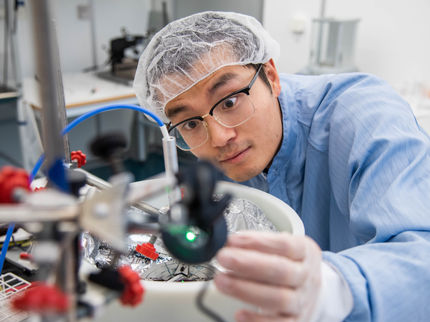Technique enables printable and rewritable color images
Advertisement
A chemical process that allows color images to be printed on specially coated paper and then erased so that different images can be printed on the same paper has been developed by researchers at Rice, Yonsei and Korea universities.

These structural colors were printed on the same sheet of paper coated with copolymers through the application of ammonium persulfate and ethanol. Hydrogen bromide was used to neutralize the solvents and create a blank paper on which to print again.
Rice University
The technique makes use of structural colors, which have different properties than the ink dyes used for standard printing. The standard dyes absorb all the colors of the spectrum except for the color that is visible to the eye, such as red or blue, and the colors fade over time. Structural colors are determined by the selective reflections of certain colors at certain angles. They're made from one-dimensional stacks of layered polymers, called block copolymers.
"Copolymers are soft, stretchable and deformable," said Ned Thomas, Rice's Ernest Dell Butcher Professor of Engineering and professor of materials science and nanoengineering, of chemical and biomolecular engineering and of chemistry. "You can swell or shrink them and change their shape and dimensions, which will affect which color they reflect."
Thomas said one of his former Ph.D. students at MIT, Cheolmin Park, who is now a professor at Yonsei University, wanted to collaborate on developing printable and rewritable copolymer structural colors.
The researchers found that they could use a single, colorless, water-based ink based on ammonium persulfate (APS) to control how the copolymers cross-link in various locations, which impacts their subsequent thickness and hence the structural colors that are reflected. APS stops the swelling of the copolymers, and the thin layer reflects blue. Ethanol was used to thicken the copolymers, which reflected red. By applying varying amounts of ethanol and APS to paper that is coated with copolymers, the researchers were able to control the swelling and shrinking of the molecules and generate the colors and patterns needed to create a picture. Large amounts of APS stopped all swelling, which resulted in black images because there was no reflection.
The researchers also discovered that applying hydrogen bromide to the paper removed or erased the APS, so the reflections were neutralized, which "reset" the system so that the paper could be used again. They printed and erased images more than 50 times on the paper, with resolution similar to that of a commercial office inkjet printer.
Thomas said refinements will be needed before this technique is commercially viable. Because ethanol evaporates, the reflective patterns disappear, so the researchers are looking for a substance that is less volatile and will maintain the colors indefinitely. They also need to find an alternative to hydrogen bromide, which is toxic and not environmentally friendly.
Thomas thinks the technique has the potential to be cost-effective because it will require only one ink -- the APS -- and a modified inkjet printer that uses paper coated with copolymers, which should cost "pennies per sheet," he said. "This could be really useful when you want to reconfigure, recolor and reshape messages on signs or clothing."































































